Archive:Electricity generation statistics – first results
- Data from June 2011, most recent data: Further Eurostat information, Main tables and Database.
This article takes a look at the most recent statistics (provisional 2010 data) on the volumes of electricity that have been produced and supplied at the level of the European Union (EU), the euro area (EA-16) and the totals for the EU-27 plus Norway, Croatia and Turkey.
As illustrated by Figure 1, the supply of electricity in EU-27 increased by 3.2% in 2010 compared to 2009, but it is still below the volume of supply for 2008.

(in GWh)
Source: Eurostat (nrg_105a), (nrg_105m)

(in %)
Source: Eurostat (nrg_105a), (nrg_105m)

(in %)
Source: Eurostat (nrg_105a), (nrg_105m)
Main statistical findings
Production of electricity
After the significant decrease of electricity production in 2009 (-4.9 %), caused by the economical crisis, the volume of produced electricity at EU-27 level increased in 2010 by 3.6 % compared to the preceding year.
Tables 1 to 11 show the production and supply data for EU-27, euro area and the total of all EU Member States plus Norway, Croatia and Turkey, by using provisional data for 2010 (2008 and 2009 data are final annual figures).
Estonia (+45.5 %), Latvia (+24 %), Luxembourg (+19.1 %), Finland (+11.2 %) and Sweden (+8.4 %) are the Member States that recorded the largest increases in electricity generation. Estonia and Latvia exported increased volumes of electricity to Lithuania that closed a nuclear power station in 2010.
As regards the structure of electricity generation in 2010 (Figures 2 and 3):
- the generation of conventional thermal electricity increased by 1.4 % in the EU-27 and accounted for 54.5 % of total generation;
- the generation of electricity by nuclear power plants also increased in the EU-27 (+2.6 %) and accounted for 27.6 % of the total;
- the electricity generation by hydro and wind increased in the EU-27 by 10 % and 9.1 % respectively and represented 12.4 % and 4.6 % of the total;
- the electricity generation by solar increased by 58.9 % in the EU-27 and represented 0.7 % of the total.
Norway recorded a decrease in total generation (-7.1 %), in Turkey and Croatia, generation increased in 2010 by 7.9 % and 10.6 % respectively compared to 2009.
Although the electricity generated by nuclear power plants increased by 2.6 %, its share decreased slightly from 27.8 to 27.6 % between 2009 and 2010.The largest share of electricity generated by nuclear in the 14 EU Member States that have nuclear facilities to produce electricity can be found in France (75.0 %), followed by Slovakia (52.6 %), Belgium (51.2 %), Hungary (42.4 %) and Sweden (38.1 %). Germany that has decided to close down its nuclear power plants during the next decade has a share of 22.9 %.
Electricity production from biofuels was not reported separately in the provisional 2010 data, and is included in the conventional thermal electricity production.
Electricity supplied to the market
The volume of electricity that is supplied to the market is defined as the total net volume of generated electricity minus export plus import minus the electricity that is absorbed by pumping. As illustrated in Figure 1, the supply of electricity in EU-27 increased by 3.2 % in 2010 compared to 2009, but it is still below the level of 2008.
In 2010, the aggregated EU-27 imports and exports of electricity are nearly identical.
When looking at supply statistics at national level, the largest increases could be observed in Luxembourg (+8.1 %), Finland (+7.6 %), and Slovenia (+7.3 %). Supply of electricity increased in the 5 largest EU Member States, France (+4.4 %), Germany (+3.6 %), Spain (+2.2 %), Italy (+2.0 %) and in the UK (+1.5 %). In Turkey, the supply increased by 7.9 % compared to 2009.
Decreases in supply figures were observed in Portugal (-11.2 %), Greece (-5.4 %) and Malta (-2.6 %).
Further Eurostat information
Publications
- Panorama of energy - Panorama April 2009
- European electricity market indicators 2008 - Statistics in focus 11/2010
- Renewable energy statistics - Statistics in focus 56/2010
- Energy, transport and environment indicators - Pocketbook February 2011
Main tables
- Energy (t_nrg), see:
- Main indicators - Energy Statistics (t_nrg_indic)
- Energy Statistics - quantities (t_nrg_quant)
- Energy Statistics - prices (t_nrg_price)
Database
- Energy (nrg), see:
- Main indicators - Energy Statistics (nrg_indic)
- Energy Statistics - quantities (nrg_quant)
Dedicated section
Source data for tables, figures and maps on this page (MS Excel)
Methodology / Metadata
- Energy Statistics (ESMS metadata file - nrg_indic_esms)
- Energy Statistics - quantities (ESMS metadata file - nrg_quant_esms)
Other information
- Regulation 713/2009 of 13 July 2009 establishing an Agency for the Cooperation of Energy Regulators
- Regulation 714/2009 of 13 July 2009 on conditions for access to the network for cross-border exchanges in electricity
- Directive 2009/72/EC of 13 July 2009 concerning common rules for the internal market in electricity
External links
- Eurelectric - Electricity for Europe - Statistics
- European Commission - Energy - Gas & Electricity - Electricity Regulatory Forum (Florence)
- European Commission - Energy - Market observatory - Electricity
- International Energy Agency (IEA) - Electricity

